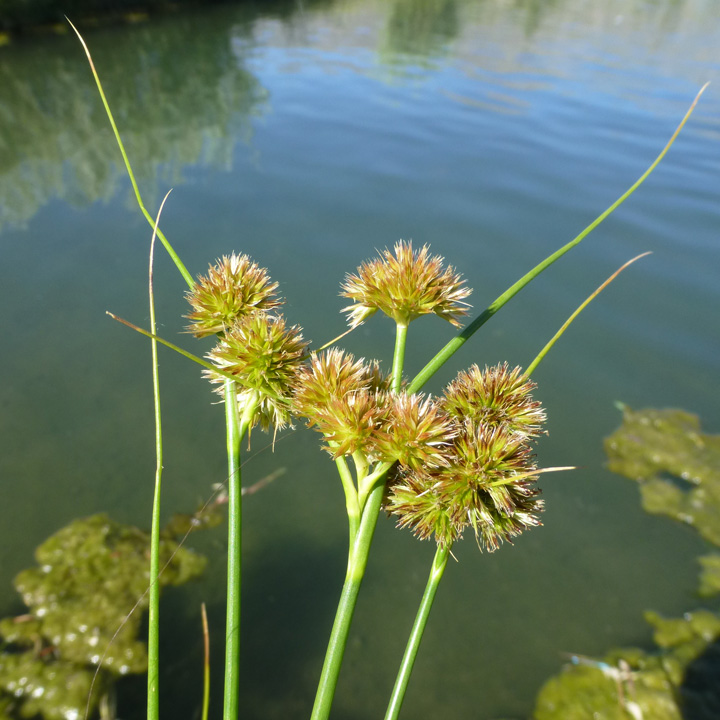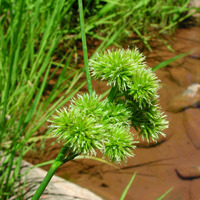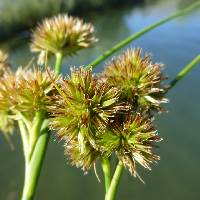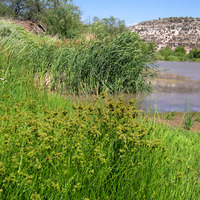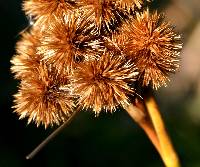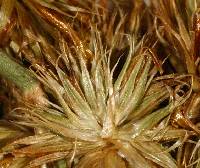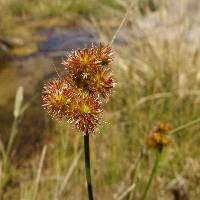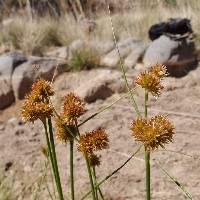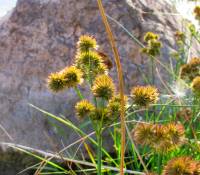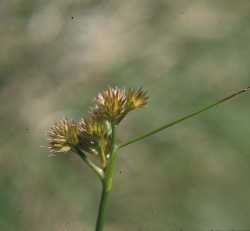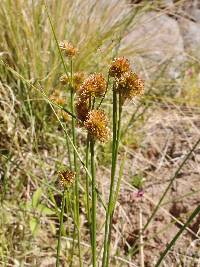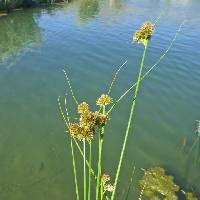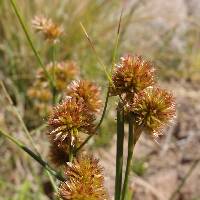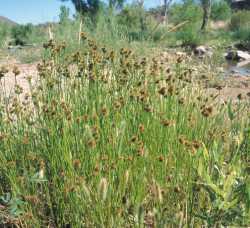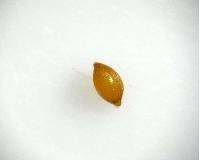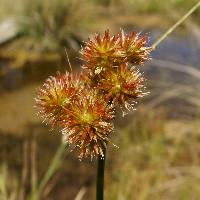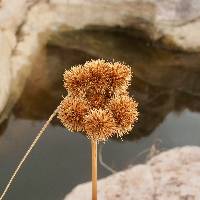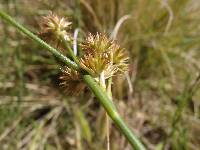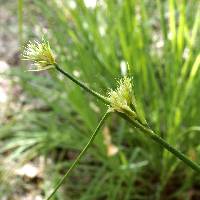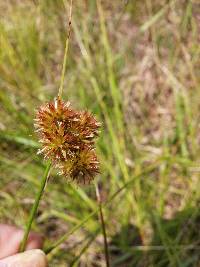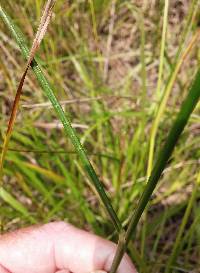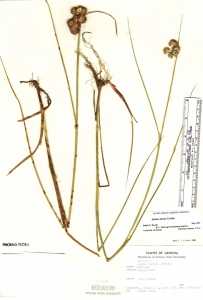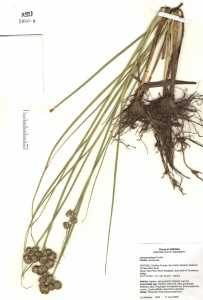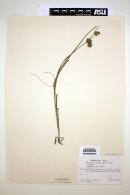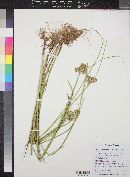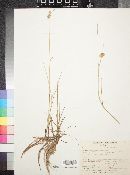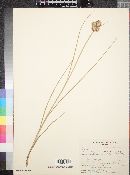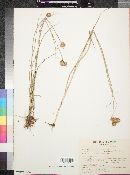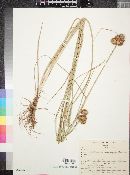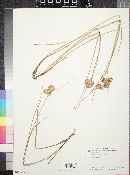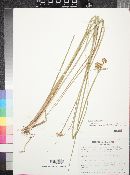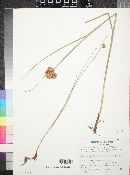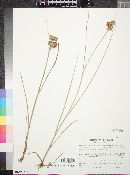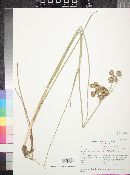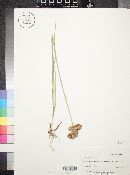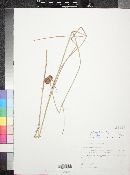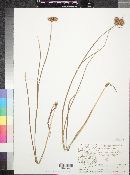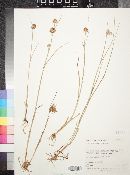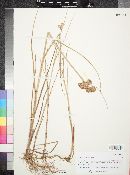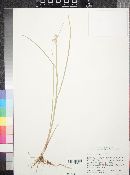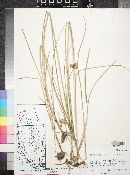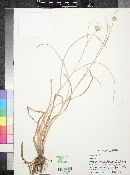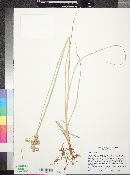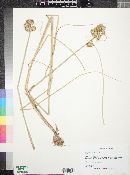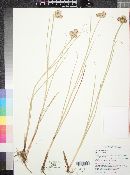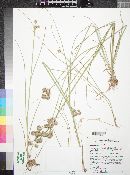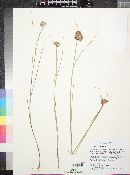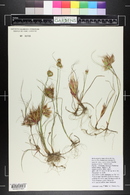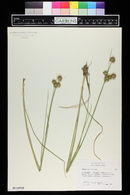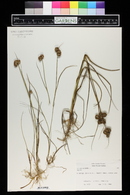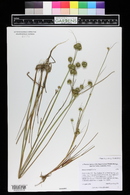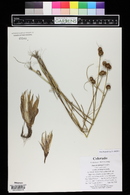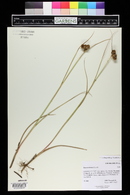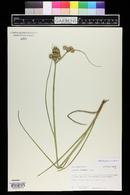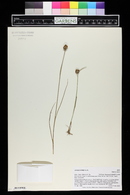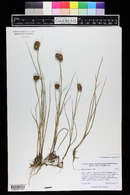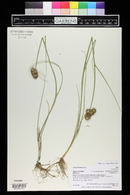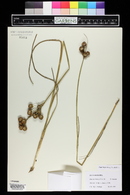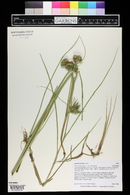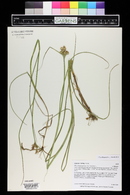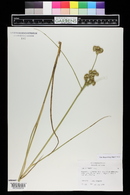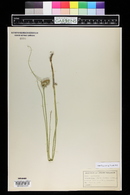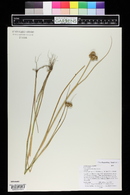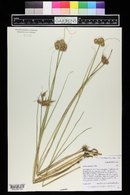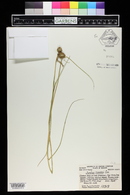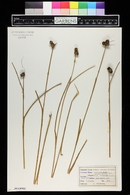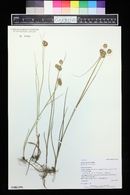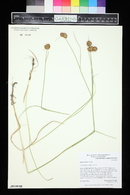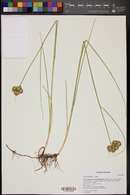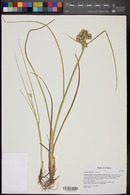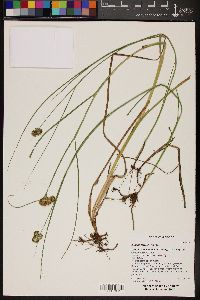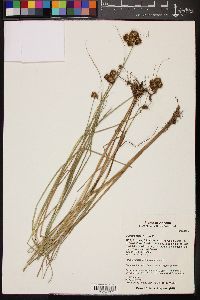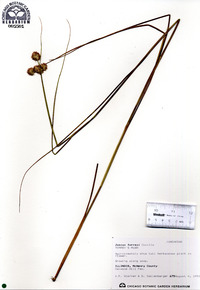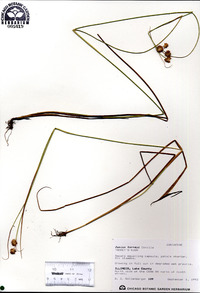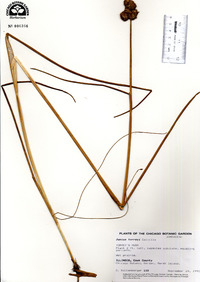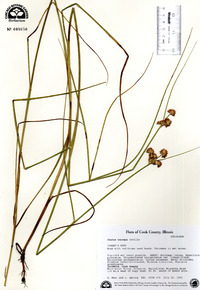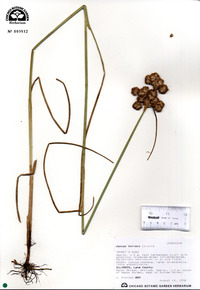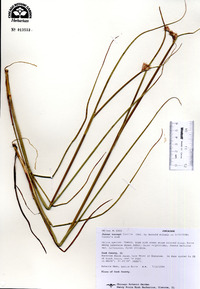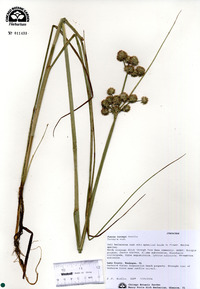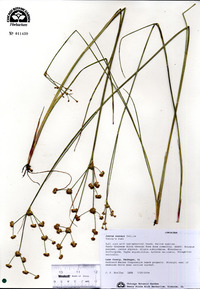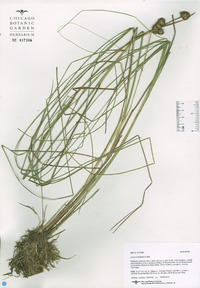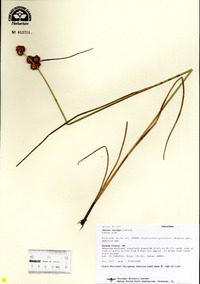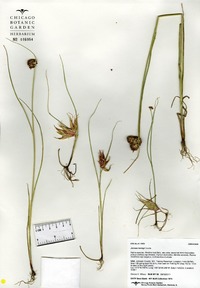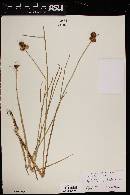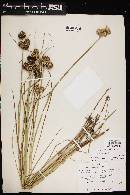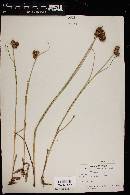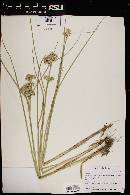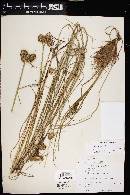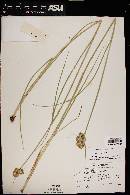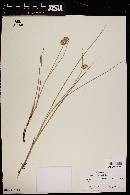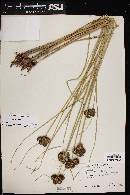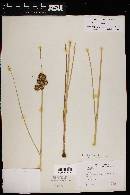
|
|
|
|
Family: Juncaceae
Torrey's Rush, more...torrey rush
[Juncus nodosus var. megacephalus Torrey, moreJuncus torreyi f. brevipes Farw., Juncus torreyi f. longipes Farw., Juncus torreyi var. paniculatus Farw.] |
Herbs, perennial, rhizomatous, (3--)4--10 dm. Rhizomes 1--3 mm diam., with swollen nodes. Culms erect, terete, 3--5 mm diam., smooth. Cataphylls 0. Leaves: basal 1--3, cauline 2--5, auricles 1--4 mm, apex rounded, scarious; blade strawberry-colored, green, or pink, terete, 13--30 cm x 1--5 mm. Inflorescences terminal clusters of 1--23 heads or single heads, 2--5.5 cm, branches spreading; primary bract erect to ascending; heads 25--100-flowered, globose, 10--15 mm diam. Flowers: tepals green to straw-colored, occasionally reddish, lanceolate-subulate; outer tepals (3.7--)4--6 mm, apex acuminate; inner tepals (3--) 3.4--4.6 mm, apex acuminate; stamens 6, anthers 1/2 filament length. Capsules equaling perianth or slightly exserted, straw-colored or chestnut brown, 1-locular, lance-subulate, 4.3--5.7 mm, apex tapering to subulate tip, valves separating at dehiscence, fertile throughout or only proximal to middle. Seeds oblong to ellipsoid, 0.4--0.5 mm, not tailed; body clear yellow-brown. 2n = 40. Fruiting early summer--fall. Wet sandy shores, edges of sloughs, along slightly alkaline watercourses, swamps, sometimes on clay soils, calcareous wet meadows, and alkaline soils; 0--600; Alta., B.C., Man., N.B., Ont., Que., Sask.; Ala., Ariz., Ark., Calif., Colo., Ga., Idaho, Ill., Ind., Iowa, Kans., Ky., La., Maine, Md., Mass., Mich., Minn., Miss., Mo., Mont., Nebr., Nev., N.H., N.J., N.Mex., N.Y., N.Dak., Ohio, Okla., Oreg., Pa., S.Dak., Tenn., Tex., Utah, Vt., Va., Wash., W.Va., Wis., Wyo.; Mexico (Baja California, probably elsewhere in n Mexico). Perennial grasslike forb 30 cm - 1 m tall Leaves: one to three basal and two to five alternate on stem, strawberry-red to pink or green, 13 - 30 cm long, 1 - 5 mm diameter, linear, grasslike, round in cross section, and with distinct crosswise partitions inside (septate). The leaves also have a thin and papery, basal, 1 - 4 mm long, round-tipped, ear-like appendage (auricle) at the top of the leaf sheath. Inflorescence: a terminal, 2 - 5.5 cm long, dense, spreading, short-branched structure with branches ending in one to twenty-three, globose, 1 - 1.5 cm diameter flower clusters. Each flower cluster is a compact head of 25 to 100, tiny, radially symmetric flowers, but very commonly the flower clusters are converted to vegetative aggregates of small bulbs (bulblets) that can have the appearance of insect galls. Stamens: six, with anthers half the length of the filaments. Pistil: with one superior ovary, and three stigmas. Fruit: single-chambered, straw-colored or chestnut-brown, 4.3 - 5.7 mm tall (equal to or only slightly taller than tepals), very narrowly lance-shaped capsules with slender-tapering, bristle-like tips. Stems: erect, smooth, stout, round in cross section, 3 - 5 mm diameter, and arising from 1 - 3 mm diameter rhizomes with swollen nodes. Seeds: many, clear yellow-brown, 0.4 - 0.5 mm long, oblong to ellipsoid, with short-pointed or abruptly narrowed tips, but without distinct narrowed tails at the ends. Tepals: six in two whorls of three, green to straw-colored or occasionally reddish, very narrowly lance-shaped with long-tapered, pointed tips. The three outer tepals are usually longer (4 - 6 mm) than the three inner tepals (3.3 - 4.6 mm), and the outer tepals often have much more rigid and slender bristle-like tips. Similar species: Juncus torreyi is very similar to and often confused with J. nodosus, except that species has smaller auricles at the top of the leaf sheaths (only 0.5 - 1.7 mm long), the capsules normally extend beyond the tepals, the flower heads are rarely converted to vegetative bulblets, all six tepals are about the same length, the outer tepals do not have rigid, bristle-like tips, or at the very least the inner three tepals are similarly shaped to the outer three. Other similar species with six stamens and non-tailed seeds have fewer flowers per head and the heads consequently do not appear to be globular or rounded. Flowering: June to October Habitat and ecology: Somewhat common, in a wide variety of moist habitats with both sandy and finer soils, including ditches and other degraded sites. Occurence in the Chicago region: native Etymology: Juncus is the classical name for Rush. Torreyi is named after John Torrey (1796 - 1873). Author: The Field Museum Stems stout, rigid, erect, 4-10 dm, arising singly from the nodes of cord-like rhizomes that are evidently tuberous-thickened at intervals; cauline lvs 2-5, the blades terete, septate, usually divaricate, 1-3 dm נ1-3 mm; margins of the sheaths pale and scarious, prolonged into scarious auricles 2-5 mm; infl usually dense, 2-4 cm, occasionally open and to 8 cm, with 2-10(-20) globose, 25-100-fld heads 10-15 mm thick; fls eprophyllate; tep linear-subulate, tapering to very slender, rigid points, the sep 3.5-5.5 mm, the pet evidently shorter; stamens 6; fr 4.5-5.7 mm, otherwise as in no. 31 [Juncus nodosus L.]; 2n=40. Wet sunny places or shallow standing water, especially on prairies; N.Y. and s. Ont. to Ky. and Tex., w. to Sask., Wash., Calif., and n. Mex.; also at scattered stations e. to Me. and N.J. and in the Gulf states. Gleason, Henry A. & Cronquist, Arthur J. 1991. Manual of vascular plants of northeastern United States and adjacent Canada. lxxv + 910 pp. ©The New York Botanical Garden. All rights reserved. Used by permission. FNA 2000, Martin and Hutchins 1980, Kearney and Peebles 1969, Wiggins 1964 Common Name: Torrey's rush Duration: Perennial Nativity: Native Lifeform: Graminoid General: Perennial rushes, 40-100 cm tall, from long-creeping rhizomes 1-3 mm in diameter; stems emerge, usually singly, from swollen nodes on the rhizomes spaced up to 8 cm apart; stems round in cross section, 1-4 mm diameter at the base. Vegetative: Each stem has several leaves, 1-2 mm wide and 6-50 cm long; leaf blades round, hollow, and septate (with internal partitions or crosswalls); leaf sheaths glabrous and glaucous (waxy); auricles at base of blade 1-4 mm long, rounded, and scarious, sometimes united to form a true ligule. Inflorescence: Terminal panicle of 1-23 spherical heads, the entire panicle 2-5 cm long with spreading branches and a single subtending bract which looks like a leaf blade and is longer than the inflorescence; heads 25-100 flowered, globose, 10-15 mm in diameter; flowers with 6 tepals (petal-like structures) 4-5 mm long, lanceolate-subulate, green to straw-colored, often reddish toward the tip. Capules 4-5 mm long and less than 1 mm wide, equalling or slightly longer than the tepals; seeds less than 0.5 mm long, golden-brown. Ecology: Found on stream banks and lakeshores, wet meadows, swamps, ditches, and open wetlands, tolerates alkaline conditions well; below 7,000 ft (2134 m); flowers May-September. Distribution: Throughout the US except the Southeast and Pacific Coast; also in s CAN and n MEX. Notes: J. torreyi is most easily recognized by its flowers which are tightly clustered in spherical heads at the tops of the stems. Also note the leaf blades which are round in cross section and hollow; if you look closely you can see the septa (partitions or cross-walls) within the leaves, dividing the hollow space within into chambers. Most easily confused with J. acuminatus, which also has flowers in globose heads and round, septate leaves. However, Juncus acuminatus is clump-forming plant, not rhizomatous as is Juncus torreyi. More minute features to tell them apart are the capsule shape, which is subulate (wedge shaped near the tip) in J.torreyi and acute (with a pointed tip) in J. acuminatus; and the tepals which are 4 mm or longer in J. torreyi and less than 3.5 mm long in J. acuminatus. Ethnobotany: Ceremonial uses. Etymology: Juncus comes from the Latin jungere, to join or bind; torreyi is named for John Torrey (1796-1873) a significant figure in American botany. Synonyms: None Editor: SBuckley 2010, FSCoburn 2015, AHazelton 2017 From Flora of Indiana (1940) by Charles C. Deam Common, especially in the lake area, in ditches, sloughs, and low prairies and on the borders of lakes, ponds, and creeks. It grows in both clay and sandy soils. …… Indiana Coefficient of Conservatism: C = 3 Wetland Indicator Status: FACW |
|
|
|

